Ten species of fish and beetles that live in underground water and five species of spiders and scorpions that live underground may have stopped plans for a uranium mine in Western Australia. The rejection by the Environmental Protection Authority (EPA), an arm of the state government, which is presently ultra-conservative, staunchly pro-uranium, also addresses wider environmental and community concerns. Cameco Australia Pty Ltd, a 100% subsidiary of Canada-based Cameco, one of the world's largest uranium miners, wants to develop an open pit mine for uranium ore and associated processing facilities at Yeelirrie, 400 miles north east of Perth, the state capital. And a media release shows they haven't given up.
Cameco doesn’t yet produce uranium in Australia, but has been actively exploring there since 1996 in the Northern Territory and Western Australia, always on Aboriginal land. At Yeelirrie, the state's biggest uranium deposit, more than 10,000 drill holes were sunk.
“This is great news for the pastoralists and community, everyone is beside themselves with relief and joy; though the war is not over the battle has been won,” wrote Mia Pepper, Nuclear Free Campaigner at the Conservation Council of Western Australia. "The fear was that the uranium mine would destroy 100 per cent of water reserves, which is the habitat of the species, which are unique to this area due to their isolated evolution. Building a mine would mean to completely drain those water reserves," Pepper told the WAToday news website.
Jim Green, anti-nuclear campaigner at Friends of the Earth, quipped: “Big congrats to Mia on a spectacular outcome! And thanks to the underground Stygofauna, spiders and scorpions for their contribution to the campaign.”
In a media release the Conservation Council of WA and the Australian Conservation Foundation say the decision was based on the unacceptable risks the mine plan posed to subterranean fauna and also addresses wider environmental and community concerns.
"This is an important decision that prioritises the survival of a number of different species and the health and wellbeing of the local community," said Pepper.
"CCWA's
submission to the EPA identified the likely extinction of several species of
underground fauna, known as stygofauna and troglofauna, if the proposal were
approved and it is pleasing to see the EPA has considered that evidence.
"The EPA recommendation has been met with great relief among pastoralists,
Aboriginal communities and environment groups who continue to campaign against
uranium mining in WA.”
Cameco bought the Yeelirri tenement from the big diversified miner, BHP Billiton, in 2012 for 430 million US dollars. BHP Billiton had conducted extensive and systematic surveys of subterranean fauna.
"This is an important decision that highlights the importance of extensive surveying for subterranean fauna and acting to prevent extinctions." National environment groups have joined their state counterparts in welcoming the EPA's call.
"We congratulate the EPA for making this important, clear and strongly evidence-based recommendation," said the Australian Conservation Foundation's Dave Sweeney. “ACF expects and looks forward to the Environment Minister upholding the EPA's recommendation." Cameco's Yeelirrie proposal was assessed at the highest level of assessment - a Public Environment Review – and was open for public comment for 12 weeks, attracting 169 responses and a further 2,946 pro forma submissions.
Australia has been a world leader in uranium production for many years, currently the third largest producer after Kazakhstan and Canada. It has the largest known uranium reserves – 31% of the world total.
Cameco Australia has done exploration and development for almost two decades. It is one of the world's largest uranium producers, accounting for about 18% of global production from its mines in Canada, the US and Kazakhstan.
The Yeelirrie proposal is to mine up to 7,500 tonnes of uranium oxide concentrate per year over 22 years, to be trucked by road for export through the Port of Adelaide in the neighbouring state of South Australia.
“Infrastructure would include two open pits, processing facilities, roads, accommodation, and stockpile and laydown areas,” says the company website.
Cameco says in a media release that it “respects the findings of the EPA and acknowledges the complexity and uncertainty involved with assessing subterranean fauna. Sampling and impact management for subterranean fauna at Yeelirrie is very complex and this is reflected in the EPA’s findings.
“We believe that with further sampling and research, subterranean fauna can be appropriately managed at Yeelirrie and we will work with government agencies and stakeholders to find a way forward.”
More than 850 samples have been taken from the Yeelirrie project area, which has identified 73 species of stygofauna. Of these, eleven species are currently only known from the impact area, the release states.
With uranium prices hovering at an eleven-year low, Cameco president and CEO, Tim Gitzel, noted in their second quarter financial results: “Market conditions have become increasingly challenging over the past five years.
“Primary supply has simply not responded to decreased demand, and coupled with an abundance of secondary material available today, the uranium market continues to be oversupplied. As a result, prices have remained under pressure, and because we don’t know how long the current weak conditions will persist, we must manage the company with that uncertainty in mind.
“Despite the current market challenges, we remain confident in nuclear power as an important part of the long-term global energy mix. Based on the reactor construction that is underway around the world today, we continue to expect uranium demand to increase in the long-term.”
Traditional owners at Yeelirrie have fought against uranium mining for more than 40 years. They welcome the EPA decision but remain wary.
Indigenous leaders from nearby communities are concerned the project would affect their water supplies and 28 threatened species in the
Richard Evans Koara, elder and co-founder of the West Australian Nuclear Free Alliance said: “The EPA decision to protect subterranean fauna is a good decision and the right decision and we are happy with the outcome. But we believe the EPA has underestimated the risk to bush foods, public health and water and most importantly our cultural heritage and our community’s opposition to the mine.
“I invite the Minister - who has never spoken to us before - to come and meet with us, the Traditional Owners of Yeelirrie, before making a decision about our country. No minister has come to talk to us about that country. Yeelirrie is an important place in our culture, it is a dreaming site important to us and other tribes around us. In the short time since WA was colonised there have been drastic changes to the ecosystem and the country.
“Uranium is different, it is poison, it is dangerous and stays dangerous for thousands of years. Long after the company is gone, long after the minister is gone there would be impacts from a uranium mine that would pose a threat for every generation to come. I’m here to protect that country, for me and my grandchildren and their grandchildren. It’s not just about protecting this country for us – but uranium threatens communities and country from the cradle to the grave, at home and overseas. This is our responsibility and we take that responsibility seriously. We have to leave this poison where it is.
“Australian uranium was used at Fukushima, uranium from South Australia and the Northern Territory. I don’t want uranium from my country to be in the next nuclear disaster. I don’t want that responsibility on my shoulders. What I want is for the minister to come and meet with us, listen to what we have to say, listen to what the EPA has said and say no to Yeelirrie.”
An Aboriginal group, supported by non-Indigenous Australians and foreigners, that has walked the country earmarked for uranium mining once a year for five years is about to set off on its 6th walk. They say “this year’s walk will be a bit of a celebration of today’s decision. Although we are also aware that Cameco will not give up that easy, this is still a great announcement that we were not expecting. We must also remember that this is something that the local community has been fighting against for over 40 years."
Walkatjurra Walkabout has a week left to crowd-fund $4,000 to support Aboriginal people to come on the walk and to purchase much needed equipment. You can click here to donate. For some background on the Walkabout and Yeelirrie go to the comments section below.
A leader of the local Ngalia tribe, Kado Muir, said that after 46 years of opposition to uranium mining “basically the message we have is that by standing strong for country we’re able to show that the mining industry don’t always win and Aboriginal people who stand up for their country can succeed, as well as working with the environment movement in protecting important species”. Muir is an artist, anthropologist, indigenous rights activist and an applicant on a native title claim to land.
Western Australia’s main daily newspaper, The West Australian called the EPA’s rejection “a surprise move” and noted that its finding will be open to a two-week public appeal period, closing Wednesday, August 17, before Environment Minister Albert Jacob makes a final decision. “The anti-nuclear lobby will cheer the EPA recommendation though the reality is Yeelirrie's development would not go ahead in this climate of a long-term depressed uranium price,” the paper commented.
A leading US finance publisher, Forbes, noted that Cameco now has to wait for a political decision from the state government, though it is unlikely that the environmental agency will be over-ruled". It had the delicious headline “Tiny Bugs Block The Development Of An Australian Uranium Mine”.
“If proof was needed that size really does matter consider the case of the bugs that you will probably never see blocking the development of a $500 million uranium mine in Western Australia. The Yeelirrie project of Canada’s Cameco Corporation had cleared all environmental hurdles until it bumped into families of stygofauna, miniature critters that generally live in underground water and rarely measure more than half-an-inch long. Some stygofauna, a group of subterranean animals that include tiny worms, mites and insects, are so small that some can measure as little as one hundreth of an inch.”
Senator Scott Ludlam, deputy leader of the Australian Greens and their
nuclear spokesperson, applauded “a
rare win” and urged environment minister Jacobs to uphold the EPA's rejection. "The
Yeelirrie uranium mine was first proposed in the 1970's and has faced strong
local and state wide community opposition for decades”. "Today's decision
by the EPA should be the final nail in a proposal that should never have seen
the light of day. The onus is now on Albert Jacobs to score a rare win for the
WA environment and shut this proposal down once and for all."
Ludlam, who is from Western Australia, congratulated pastoralists, anti-nuclear campaigners and local traditional owners for their tireless work to oppose a project that would have been an environmental disaster.

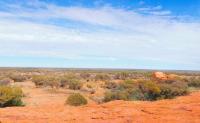
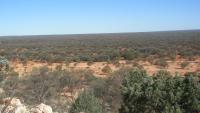

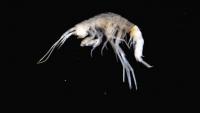
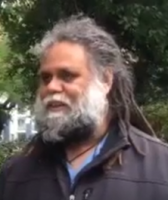
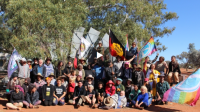
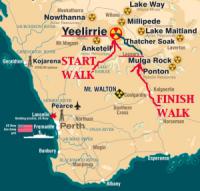
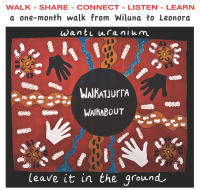
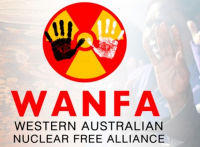
Background on Walkatjurra Walkabout & Yeelirrie plan
Over the years several hundred people have visited the Yeelirrie and Wiluna proposed uranium mine sites with Traditional Owners, a walk for a nuclear free future. The first Walkatjurra Walkabout was held in 2011 – a three month walk from Wiluna to Perth.
The walk was organised to demonstrate the opposition to uranium mining, there were many great impacts in the local community from the walk that were unexpected, at the request of people in the Leonora community the walks have continued. Smaller walks have been held every year since 2011 from Wiluna to Leonora via the proposed uranium mines at Wiluna and Yeelirrie. The walks are led by the Walkatjurra rangers from Leonora and include people from across Australia and have included international visitors from the US, Taiwan, Japan, France, Lapland, Greece and England.
Last year a film “Walking for Country” was produced, it is a documentary on the Walkatjurra Walkabout. The film interviews walkers and traditional owners about their personal opposition to uranium mining and why they are walking in protest. “Walking for Country” has been accepted into a number of international film festivals and is a finalist for the category “Best Foreign Short Doco” at the TMC London Film Festival.
The Yeelirrie area is currently under Native Title application by the Tjiwarl clan. The mine proposal threatens the area which is part of the Seven Sisters Dreaming songline. The word Yeelirrie translates to the word Yullala – which means to weep or mourn. Yeelirrie is often referred to as a “place of death”. There are stories that relate to death that are connected to that area. The cultural stories and connections with Yeelirrie comprise one of the core reasons Traditional Owners are opposed to uranium mining.
Over 3,000 people have written to the State Environmental Protection Authority to voice their opposition to the Yeelirrie uranium mine, and in support of the Parnngurr Aboriginal community who actively oppose the uranium mine and are the community closest to the proposal.
The Yeelirrie uranium deposit was found by Western Mining Corporation (WMC) in 1972. In the 1980’s WMC dug several trial mine pits at Yeelirrie. WMC transported 130,000 tonnes of ore to Kalgoorlie for trial processing. Tailings were later transported back to Yeelirrie and put back into the mined out pits.
In 1983 the Federal Government introduced the Three Mine Policy to limit the number of uranium mines in the country to three, and Yeelirrie plans were abandoned, leaving the site contaminated and un-remediated.
The site was not fenced or signed, there was public access to contaminated sites and dams – there are reports that the dam at Yeelirrie was used for ‘recreation’ and may have involved people swimming in contaminated water.
In 2005 BHP Billiton acquired WMC mines – including the Olympic Dam uranium mine in South Australia and the Yeelirrie Deposit in WA.
In 2006 the National Three Mines Policy was lifted – allowing more than three uranium mines to operate at any time. In 2008 the WA Liberal State Government lifted the ban on uranium mining. 2008 – 2011 BHP Billiton began developing and progressing the environmental assessment of the Yeelirrie uranium mine.
The Native Title claimant group directed their representative body Central Desert Native Title Service not to consult or engage with BHP Billiton – as there was unanimous opposition to uranium mining at Yeelirrie – therefore there was nothing to discuss with BHP Billiton.
The Native Title Act has been criticised for not meeting United Nations Declaration on the Rights of Indigenous People, for favouring resource companies above Native Title holders who are forced to negotiate in an uneven playing field, within a short time frame and with no rights to veto. It is expected that the prospects of Native Title in the region could be affected by the presence of mining interests.
Cameco propose mining the deposit with one large, shallow open pit - 9km long, 1.5 km wide & 10m deep – the huge disturbed area significantly increases the risk of dust contamination and increases the risk of exposure to workers, cattle and neighbouring pastoral stations, native wildlife and the public.
Recently here on linksunten
Suicide of 15-year-old boy in Don Dale - broken and ruined lives
"To break the will and determination of Aboriginal people cowardly governments attack our youth"
“This week, Australia is a boy in a hood in a cell"
NT Juvenile Detention Abuse Royal Commissioner Needs No Introduction To Black Territorians
Aborigines were NOT nomads – stirring for more teaching of Aboriginal history
Aboriginal children stripped, tear-gassed, brutalised in Northern Territory prison
Support swelling for treaty, falling for recognition
New threat to remove Aborigines from tiny remote communities
Aboriginal mothers 17.5 times more likely to be victims of homicide
Does Indigenous Australia Need a BlackLivesMatter Movement?
First Aboriginal woman in main parliament – tokenism or indigenous power boost?
We must die standing and fighting and not lay down and let these bastards have their own way
Aboriginal children as young as 8, 9, 10 and 11 years of age killing themselves
Indigenous owners appeal to Minister's 'human side' to shelve proposed nuclear waste site
Let's have treaty and constitutional recognition
There are lots of ways to say sorry, but Indigenous Australians need a treaty now
Ancient Euahlayi astronomy parallels with Einstein's space-time theory
Aborigines can no longer eat fish from mine-poisoned river
Elation, sadness and anger over return of Aboriginal land